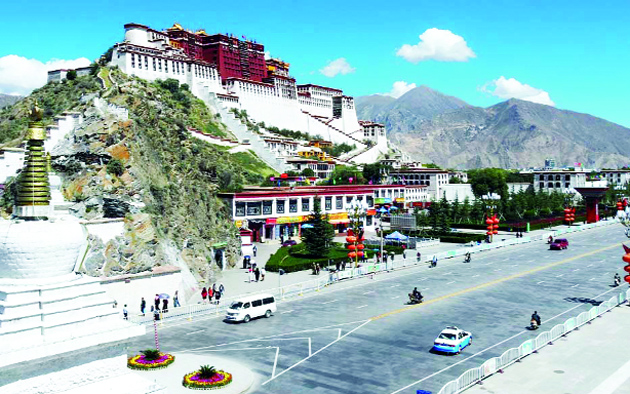Covert sinicization across our Northern Frontiers

By Col Satish Singh Lalotra
‘Surveillance breeds conformity’
Glenn Greenwald.
‘Peacetime surveillance’ or espionage represents a serious conundrum for international community which finds itself increasingly in the throes of big state actors (read nations) and often dubious way of controlling their spheres of influence. The terminology is often a colloquial rather than a legal term.
Ordinarily states perpetrate surveillance to acquire information that reveals the political strategies, economic ambitions, and military capabilities of other states and such like issues.
For centuries India has not only been buffeted by the great Himalayan ranges saving it from the northern marauders like the Huns, Mongols and such like warrior tribes but also from the harsh elements of weather failing which our rich and alluvial plains of Indo-Gangetic region would have been converted into a glacial wasteland.
Similarly the Indian psyche had been cocooned for centuries in the notion of Tibet being a formal buffer zone between the much muscular Chinese civilization and the Indian civilization, which vanished due to the perfidy and constant onslaught of Chinese method of ‘Sinicization’ in the Tibetan autonomous region.
Since any new methods initiated by the Chinese to Sinicizise Tibet have an indirect effect on India, the present article of mine precisely puts the spot light on a new method of suppressive surveillance in Tibet going by the nomenclature of ‘Smart construction sites’.
Post ‘Galwan clash’ of May/June 2020 between Indian army and the PLA have heightened the concerns of Indian establishment as never before, prompting all its levers of power in an overdrive to blunt the yellow man’s evil machinations.
The region of Tibet having a contiguous border with us spanning more than 3448 kms in its entire geographical entity is nowadays witness to a very high intensity of surveillance carried out by the Chinese in the form of innocuous looking ‘Smart construction sites’ all over the Tibetan autonomous region.
This effectively makes Tibet one of the most surveilled areas of our earth. One such evil machination unleashed by the Chinese on its hapless Tibetan populace in the recent past has been a systematic programme of eavesdropping, surveillance, and such allied methods as stated above knowing very well that a sizable population of Tibetan diaspora lives in India that will cause ripples in the community and sub-continent in particular with ominous consequences .
The ‘Smart construction site’ platform so developed by the Chinese and implemented all over the TAR (Tibetan autonomous region) envisages these sites in housing and municipal projects. The CCP (Chinese communist party) has made this SCS (Smart construction site) an intelligent service by dovetailing big data, machine control, and advanced technologies such as smart devices and mobile terminals in all its construction sites in the TAR.
Moreover the Chinese government has made it mandatory from May 2023 for all eligible new housing and municipal projects in Tibet to be in sync with this SCS platform. So far the department of housing and urban development of the Tibetan autonomous region (TAR) has reported that the platform building of the SCS in 7 cities and 34 counties in the Tibetan plateau has been completed and more than 231 building projects have been connected with this unique platform.
The most disconcerting factor in this whole episode of covert surveillance is that many of these counties are bordering the LAC with India. One of the crucial parts of the security architecture built in the TAR by Chen Quango during his tenure as the party secretary of the region from 2011 to 2016 was an integrated neighbourhood grid surveillance system combining human intelligence, real time face -recognition surveillance footage, and big data analytic.
Chen is infamously known as the architect of mass internment camps in Xinjiang prefecture. The Chinese surveillance cameras and facial /racial recognition technology is the backbone of the grid-surveillance system.
Strikingly the traffic surveillance cameras are also part of this grid surveillance. One of the most worrisome features of this SCS system is that with its construction, a massive number of cameras have been installed and maintained at the most populated areas and cities of Tibet autonomous region such as Lhasa, Shigatse, Nagchu, and Ngari prefecture.
As an example, the Ngari prefecture has close cultural links with Kinnaur and Lahul and Spiti district of Himachal Pradesh as well as with the Demchok sector of Ladakh region of Jammu & Kashmir. Beijing is using this vast number of cameras as part of SCS for policing and repressive purposes to further strengthen its establishment of intrusive surveillance in Tibet.
Moreover, the merging of civilian and military infrastructure for dual purpose use through the implementation of the famous Chinese state policy of MCF (Military civilian fusion) in the TAR has rapidly increased in the past decade.
To counter this Chinese state policy of MCF, India has woken up a tad late and set in motion its own policy of ‘Vibrant village programme (V.V.P) identifying own border villages sprung from Walong in the far eastern Arunacahl Pradesh to Hanle and Demchok in Ladakh in order to dovetail local security cum infra issues with that of national security and thus making a common cause with the border people.
From China’s perspective, according to Hao Lidong the deputy director of department of housing and urban development of the autonomous region, these SCS construction sites reduce the supervision costs of industry authorities, improve supervision efficiency, strengthen the management of dishonest enterprises, relieve local supervision pressure thus avoiding supervisory blind spots, and loopholes caused by insufficient construction.
Beijing’s promotion of the SCS system has to be understood carefully in its context. China since its annexation of Tibet in the 1950s, has continued to employ intrusive and often oppressive surveillance systems and practices to closely monitor Tibetans in both the TAR and other parts of what were before the occupation of an independent Tibet i.e. Qinghai, Sichuan, Gansu, and Yunnan provinces.
According to the CTA (Central Tibetan administration) based at Dharamshala in HP, these surveillance systems are solely aimed at monitoring Tibetans and conducting arbitrary arrests and detentions against activities including, but not limited to strong expressions of Tibetan identity and culture, disapproval of governmental policies and such like issues.
As far as India is concerned SCS system is a double whammy, since for the Indian security system Tibet is like a big black hole with hardly any actionable intelligence filtering out of the iron curtain, with an additional layer of surveillance now thrust down the throats of these hapless Tibetans to be of any use to us.
Moreover after the Galwan clash of 2020 India had clamped down on many Chinese apps, with ‘WE CHAT” being one of them. This was the sole means of communication between the Tibetans living in TAR and rest of the world.
Either India off sets this disadvantage of Tibet being a big black hole in the realm of intelligence framework for furthering our cause or gives a big push to normalize its relations with its northern neighbour with a pinch of salt.
The mandarins of power sitting at Delhi will have to take a call sooner or later. As Glenn Greenwald has rightly said…’.Surveillance breeds conformity.’
China is already conforming Tibetan population to its state policy of subjugation by way of covert and overt surveillance. Will India ever wake up from its deep slumber to play along with China on its own terms?
(The writer is a retired army officer)




